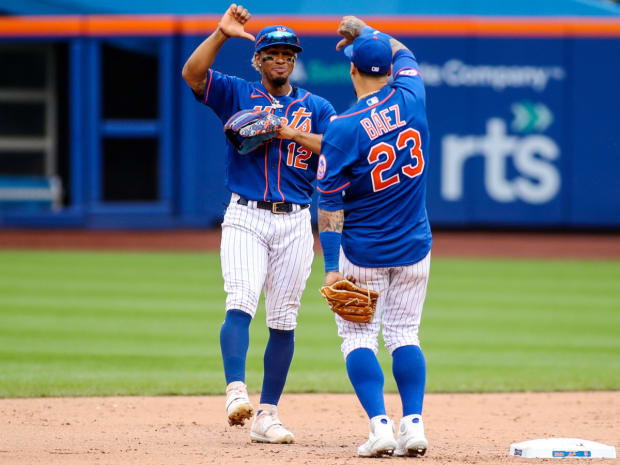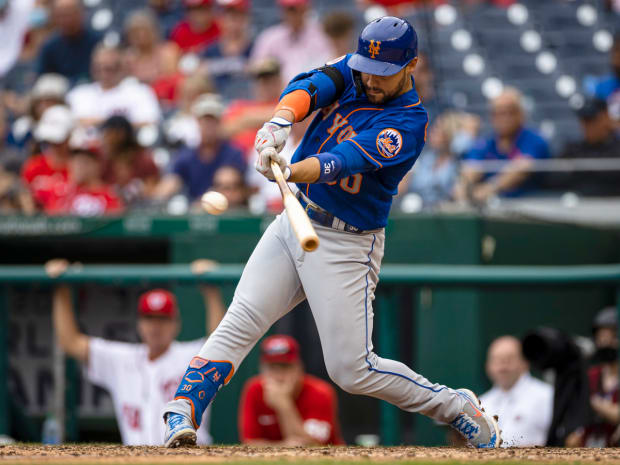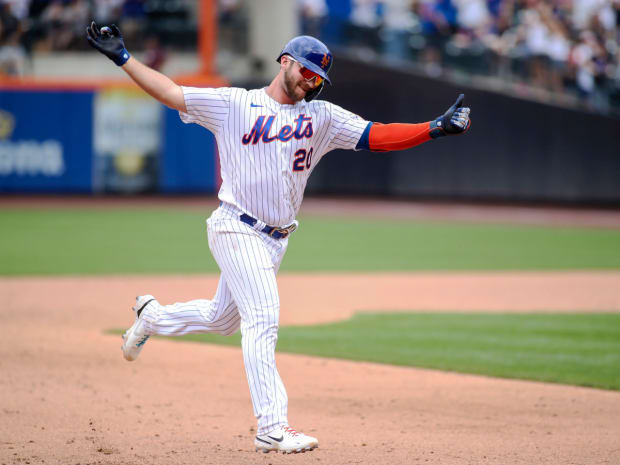Serious problems, absurd sideshows and poor play have created a cycle of dysfunction. Can they turn things around?
Welcome to The Opener, where every weekday morning you’ll get a fresh, topical column to start your day from one of SI.com’s MLB writers.
Jared Porter to Javier Báez to Zack Scott. The Mets are a favorite parlor game of connect the dots—even when there is no connection. As a
franchise treated like Prometheus’s liver, when players give the thumbs down to fans—a foolhardy but hardly serious gesture—it becomes an opportunity to pick away at the litany of Mets’ misdoings as part of the team’s “culture.”Just take the dot at face value. Two players new to New York, Báez and Francisco Lindor, both of whom had never been booed before, reacted poorly to the boos, especially on the heels of Steve Cohen, who had never been a team owner before, and Scott, who had never been a general manager before, criticizing the team. Báez and Lindor apologized, and the team has won six of seven games since.

Wendell Cruz/USA TODAY Sports
The Mets have spent five months tossed about as if stuck in the spin cycle of a washer. They have run through a franchise record 63 players, a franchise record 41 pitchers, four hitting coaches and three acting general managers. Jacob deGrom has not thrown a pitch in two months. They have been five games up and eight games out—just two months apart. Yet they reached Labor Day 3 1/2 games out of a playoff spot with 25 games to play.
How do we make sense of the Mets? The first thing you do is judge them by the competition. They are 36–25 against losing teams, but 33–43 against winning teams—worse than how the Tigers have measured up against better teams. Is that a problem of “culture?” This is Cohen’s first season owning the team for which he long has rooted. He will learn that trashing his team via Twitter is about his frustration and not about helping the team play better.
But also, under Cohen, and with the help of a consulting firm, the Mets last December launched a four-month investigation into the pay scales of big market MLB teams for their office employees, according to one team source. They also studied the salaries of similar non-baseball jobs in the New York City area. They found their employees were woefully underpaid. So the Mets instituted raises effective in April that brought salaries to industry and New York standards. Those raises were as high as $25,000 to $50,000, the source said.
Better known is how one month after the Mets hired Porter, they fired him over inappropriate messages and images sent to a female reporter in 2016, when he worked for the Cubs. Scott, his replacement, is on leave after he was arrested for driving while intoxicated last week in White Plains, N.Y. (On Thursday, Scott pleaded not guilty to a first-offense DWI charge and three other traffic charges, and his next hearing is scheduled for Oct. 7.) Throw in the banishment of former Mets manager Mickey Callaway, Lindor playing too cute about a dustup with Jeff McNeil, the failure to sign top draft pick Kumar Rocker, and the Thumbs Down “crisis,” and we have a reality show.
Narratives and dots aside, here is the on-field problem with the Mets: they are a poor offensive team that is going to have to hit good pitching to get into the postseason. Yes, they have scored 33 runs in four games against the lowly Nats this weekend. But starting Friday, the Mets play 17 of their final 21 against playoff contenders: the Yankees, Cardinals, Phillies, Red Sox, Brewers and Braves. They have hit .233 against those teams while going 22–22. Entering Sunday, the Mets were scoring runs at the exact rate of the 1962 Mets, 3.83 per game, which this year is worse than every team except Pittsburgh.
The Mets have five players who should be in their prime years (ages 26–31) producing at below their career adjusted OPS: McNeil, Lindor, Dominic Smith, Michael Conforto and James McCann. Here are some reasons why the team has underachieved at the plate:

Scott Taetsch/USA TODAY Sports
1. The Mets chase too much.
New York is one of the six teams that swing most often at pitches out of the zone. How important is strike zone discipline? The six teams that chase the most have a .459 winning percentage. The six teams that chase the least have a .561 winning percentage.
The Mets chase 33.3% of the time. The past five world champions all chased less than 30% of the time.
Baseball is a game that pivots on count leverage more than anything else. Here’s what all that chasing means for the Mets: they see more pitches behind in the count (30%) than any team in the league except the Marlins.
2. Lindor has a breaking pitch problem.
With career worsts in line drive rate, exit velocity and all three slash percentages, Lindor is having a typically down first-year break-in season in New York. Trying to justify his contract, he is selling out on pitches, which has left him vulnerable to breaking balls. Pitchers have noticed. They are throwing him 29% breaking pitches, up from 24% in 2019. Look at the steep rise in his swing and miss rate at spin:
Lindor vs. Breaking Pitches
3. Conforto lost his opposite field power stroke.
From 2017-20, Conforto hit 23 opposite-field home runs, seventh most by any left-handed hitter. He hasn’t hit an opposite field homer in more than a calendar year—since Sept. 4, 2020, off a Jake Arrieta sinker. His slugging the other way has dropped from .826 last year to .449 this year.
4. Citi Field is the worst place to hit.
Since 2013, Citi Field has the worst batting average of any of the 30 current home parks (.236), slightly behind Tropicana Field (.237) and Globe Life Park (which closed in 2019), Dodger Stadium and Petco Park (.238).
If Park Factors for hits is more to your liking (it uses three-year rolling data), Citi Field ranked last every season from 2015-20 with a Park Factor no higher than 93 (100 is average). This year it is “up” to 27th at 94.
5. The Mets are a poor baserunning team.
Only 28% of their runners score, tied with the Pirates and Yankees for the worst rate in MLB. Only 61 Mets runners scored from second on a single, the third fewest in MLB. They score from second on a single only 45% of the time. MLB average is 59%.
6. Injuries.
Pete Alonso and Smith are their only qualified hitters. Brandon Nimmo left the game Sunday with a hamstring injury in what was only his 78th game. Lindor, McNeil, McCann, Conforto and J.D. Davis also have missed chunks of time, which often leads to inconsistency.
On the day Báez and Lindor issued their apologies for “Thumbs Down,” the Mets held a 45-minute clubhouse meeting in which Alderson and several players spoke. The meeting appeared to jolt the team with a necessary re-set—to convince the players not to be distracted by the negative noise around them, be it from the media or their own fans, owner or general manager. Of even more impact have been 13 straight games against the Marlins and Nationals, two teams that are 21–46 since they checked out at the trade deadline. The Mets are 7–2 thus far in that stretch.

Wendell Cruz/USA TODAY Sports
Starting Friday, New York's final 21 games are a better test of its offense. Great hitting teams often have an alpha hitter who defines an offensive approach that becomes contagious. Think Justin Turner and now Max Muncy with the Dodgers, Aaron Judge with the Yankees, Freddie Freeman with the Braves, and Juan Soto with the Nationals. The Mets don’t have that kind of hitter.
Lindor could be that hitter, but he is not this year. The closest such player the Mets have is Alonso, a grinder who still chases a bit too much (31%) but who can grow into that role. Last month Alonso came up with a good idea: every hitter would kick money into a pot and at the end of the week the player with the lowest chase rate would win the money. And the winner turned out to be Alonso, who made plate discipline a priority.
It was not a fortune on the line—mid-three figures—but it was the message of forcing pitchers into the zone that was important. That message must stick for the final four weeks. A 17–8 finish gets the Mets to 86 wins, which might be enough for a team to sneak into the playoffs. One last narrative remains to be written.
More MLB Coverage:
• How MLB Squashed its Fake-Memorabilia Problem
• When the Mets’ Woes Are More Insidious Than Just the Jokes
• Good Vibes Only at Citi Field
• Who Is the Next Miguel Cabrera?
Serious problems, absurd sideshows and poor play have created a cycle of dysfunction. Can they turn things around?
Welcome to The Opener, where every weekday morning you’ll get a fresh, topical column to start your day from one of SI.com’s MLB writers.
Jared Porter to Javier Báez to Zack Scott. The Mets are a favorite parlor game of connect the dots—even when there is no connection. As a franchise treated like Prometheus’s liver, when players give the thumbs down to fans—a foolhardy but hardly serious gesture—it becomes an opportunity to pick away at the litany of Mets’ misdoings as part of the team’s “culture.”
Just take the dot at face value. Two players new to New York, Báez and Francisco Lindor, both of whom had never been booed before, reacted poorly to the boos, especially on the heels of Steve Cohen, who had never been a team owner before, and Scott, who had never been a general manager before, criticizing the team. Báez and Lindor apologized, and the team has won six of seven games since.

Wendell Cruz/USA TODAY Sports
The Mets have spent five months tossed about as if stuck in the spin cycle of a washer. They have run through a franchise record 63 players, a franchise record 41 pitchers, four hitting coaches and three acting general managers. Jacob deGrom has not thrown a pitch in two months. They have been five games up and eight games out—just two months apart. Yet they reached Labor Day 3 1/2 games out of a playoff spot with 25 games to play.
How do we make sense of the Mets? The first thing you do is judge them by the competition. They are 36–25 against losing teams, but 33–43 against winning teams—worse than how the Tigers have measured up against better teams. Is that a problem of “culture?” This is Cohen’s first season owning the team for which he long has rooted. He will learn that trashing his team via Twitter is about his frustration and not about helping the team play better.
But also, under Cohen, and with the help of a consulting firm, the Mets last December launched a four-month investigation into the pay scales of big market MLB teams for their office employees, according to one team source. They also studied the salaries of similar non-baseball jobs in the New York City area. They found their employees were woefully underpaid. So the Mets instituted raises effective in April that brought salaries to industry and New York standards. Those raises were as high as $25,000 to $50,000, the source said.
Better known is how one month after the Mets hired Porter, they fired him over inappropriate messages and images sent to a female reporter in 2016, when he worked for the Cubs. Scott, his replacement, is on leave after he was arrested for driving while intoxicated last week in White Plains, N.Y. (On Thursday, Scott pleaded not guilty to a first-offense DWI charge and three other traffic charges, and his next hearing is scheduled for Oct. 7.) Throw in the banishment of former Mets manager Mickey Callaway, Lindor playing too cute about a dustup with Jeff McNeil, the failure to sign top draft pick Kumar Rocker, and the Thumbs Down “crisis,” and we have a reality show.
Narratives and dots aside, here is the on-field problem with the Mets: they are a poor offensive team that is going to have to hit good pitching to get into the postseason. Yes, they have scored 33 runs in four games against the lowly Nats this weekend. But starting Friday, the Mets play 17 of their final 21 against playoff contenders: the Yankees, Cardinals, Phillies, Red Sox, Brewers and Braves. They have hit .233 against those teams while going 22–22. Entering Sunday, the Mets were scoring runs at the exact rate of the 1962 Mets, 3.83 per game, which this year is worse than every team except Pittsburgh.
The Mets have five players who should be in their prime years (ages 26–31) producing at below their career adjusted OPS: McNeil, Lindor, Dominic Smith, Michael Conforto and James McCann. Here are some reasons why the team has underachieved at the plate:

Scott Taetsch/USA TODAY Sports
1. The Mets chase too much.
New York is one of the six teams that swing most often at pitches out of the zone. How important is strike zone discipline? The six teams that chase the most have a .459 winning percentage. The six teams that chase the least have a .561 winning percentage.
The Mets chase 33.3% of the time. The past five world champions all chased less than 30% of the time.
Baseball is a game that pivots on count leverage more than anything else. Here’s what all that chasing means for the Mets: they see more pitches behind in the count (30%) than any team in the league except the Marlins.
2. Lindor has a breaking pitch problem.
With career worsts in line drive rate, exit velocity and all three slash percentages, Lindor is having a typically down first-year break-in season in New York. Trying to justify his contract, he is selling out on pitches, which has left him vulnerable to breaking balls. Pitchers have noticed. They are throwing him 29% breaking pitches, up from 24% in 2019. Look at the steep rise in his swing and miss rate at spin:
Lindor vs. Breaking Pitches
3. Conforto lost his opposite field power stroke.
From 2017-20, Conforto hit 23 opposite-field home runs, seventh most by any left-handed hitter. He hasn’t hit an opposite field homer in more than a calendar year—since Sept. 4, 2020, off a Jake Arrieta sinker. His slugging the other way has dropped from .826 last year to .449 this year.
4. Citi Field is the worst place to hit.
Since 2013, Citi Field has the worst batting average of any of the 30 current home parks (.236), slightly behind Tropicana Field (.237) and Globe Life Park (which closed in 2019), Dodger Stadium and Petco Park (.238).
If Park Factors for hits is more to your liking (it uses three-year rolling data), Citi Field ranked last every season from 2015-20 with a Park Factor no higher than 93 (100 is average). This year it is “up” to 27th at 94.
5. The Mets are a poor baserunning team.
Only 28% of their runners score, tied with the Pirates and Yankees for the worst rate in MLB. Only 61 Mets runners scored from second on a single, the third fewest in MLB. They score from second on a single only 45% of the time. MLB average is 59%.
6. Injuries.
Pete Alonso and Smith are their only qualified hitters. Brandon Nimmo left the game Sunday with a hamstring injury in what was only his 78th game. Lindor, McNeil, McCann, Conforto and J.D. Davis also have missed chunks of time, which often leads to inconsistency.
On the day Báez and Lindor issued their apologies for “Thumbs Down,” the Mets held a 45-minute clubhouse meeting in which Alderson and several players spoke. The meeting appeared to jolt the team with a necessary re-set—to convince the players not to be distracted by the negative noise around them, be it from the media or their own fans, owner or general manager. Of even more impact have been 13 straight games against the Marlins and Nationals, two teams that are 21–46 since they checked out at the trade deadline. The Mets are 7–2 thus far in that stretch.

Wendell Cruz/USA TODAY Sports
Starting Friday, New York's final 21 games are a better test of its offense. Great hitting teams often have an alpha hitter who defines an offensive approach that becomes contagious. Think Justin Turner and now Max Muncy with the Dodgers, Aaron Judge with the Yankees, Freddie Freeman with the Braves, and Juan Soto with the Nationals. The Mets don’t have that kind of hitter.
Lindor could be that hitter, but he is not this year. The closest such player the Mets have is Alonso, a grinder who still chases a bit too much (31%) but who can grow into that role. Last month Alonso came up with a good idea: every hitter would kick money into a pot and at the end of the week the player with the lowest chase rate would win the money. And the winner turned out to be Alonso, who made plate discipline a priority.
It was not a fortune on the line—mid-three figures—but it was the message of forcing pitchers into the zone that was important. That message must stick for the final four weeks. A 17–8 finish gets the Mets to 86 wins, which might be enough for a team to sneak into the playoffs. One last narrative remains to be written.
More MLB Coverage:
• How MLB Squashed its Fake-Memorabilia Problem
• When the Mets’ Woes Are More Insidious Than Just the Jokes
• Good Vibes Only at Citi Field
• Who Is the Next Miguel Cabrera?


0 Comments